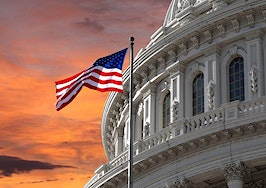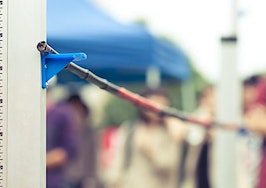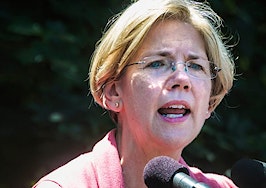- NAR membership stood at 1.17 million at the end of April and is expected to hit the 1.2 million mark sometime this year.
- According to the budget approved Saturday, NAR dues in 2017 will remain the same at $120 per member, with $40 of that going to NAR's political advocacy program, the Realtor Party.
- The board also voted to continue a $35 per year assessment on top of dues for 2017, 2018 and 2019 for its Consumer Advertising Campaign. The trade group has chosen Phil Dunphy from the TV show Modern Family as the face of that campaign.
- After the Realtor Party and the Consumer Advertising Campaign, NAR's wholly-owned subsidiary, real estate data and technology company Realtors Property Resource, is by far the trade group's biggest program expense -- and it's about to get costlier.
WASHINGTON — The National Association of Realtors got a budget boost from increased membership this year, benefiting from brokers and agents trying to get a piece of an improving housing market.
NAR membership stood at 1.17 million at the end of April and is expected to hit the 1.2 million mark sometime this year.
Because NAR’s 2016 operating budget originally assumed a membership of 1 million, that 120,000 increase in members is largely responsible for turning what was projected to be a deficit of $4.7 million this year into a surplus of $266,800 that will go into operating reserves.
In the next three years, NAR will increase its spending to match or exceed its increase in dues revenue, according to a budget proposal approved by the trade group’s board of directors Saturday.
Dues and membership
According to the budget approved Saturday, NAR dues in 2017 will remain the same at $120 per member, with $40 of that going to NAR’s political advocacy program, the Realtor Party. The current budget proposals for 2018 and 2019 also leave dues at $120 per member.
The board also voted to continue a $35 per year assessment on top of dues for 2017, 2018 and 2019 for its Consumer Advertising Campaign. The trade group has chosen Phil Dunphy from the TV show Modern Family as the face of that campaign.
NAR’s 2017 budget and the 2018 and 2019 budget proposals set a 1.2 million membership figure as the basis for dues revenue. NAR expects to bring in $181.8 million in gross revenue in 2017 with net program expenses of $181.7 million.
That would have added $56,936 to NAR’s operating reserves, but the board also voted to adopt a “unified committee communication platform” for use by all NAR committees, advisory boards, advisory groups, forums and councils that will cost a combined $201,500 in 2016 and 2017, resulting in a net use of reserves of $87,064 in 2017.
The communication platform will integrate with Realtor.org and provide NAR’s committee members with a consistent and mobile-responsive way to communicate thereby increasing productivity, according to the trade group’s Member Communications Committee.
The platform will also ensure information security because NAR will own the information, “which will not be open to Facebook, its users, or others for data mining,” the committee said.
NAR staff have identified Higher Logic as a “preferred vendor” for the platform, but are in the process of selecting a vendor and have not yet signed a contract with any vendor, NAR said.
The budget proposal for 2018 projects NAR will bring in $184.3 million in gross revenue with net program expenses of $184 million, adding $290,987 to operating reserves.
The budget proposal for 2019 anticipates NAR will bring in $184.9 million in gross revenue with net program expenses of $186.5 million, using $1.6 million of operating reserves.
NAR’s Realtor Party budget will come in with a $1.8 million deficit this year, despite increased dues income to $48 million. The program’s expenses are expected to be $49.8 million for 2016. The program’s biggest expense in this year will be $10.5 million in federal candidate independent expenditures.
After the Realtor Party and the Consumer Advertising Campaign, NAR’s wholly-owned subsidiary, real estate data and technology company Realtors Property Resource, is the trade group’s biggest program expense — and it’s about to get costlier.
RPR
RPR provides a comprehensive parcel-based database of 166 million properties and data tools to all of the nation’s 1 million Realtors free of charge.
But its business model originally assumed that the venture would become self-sustaining by 2012 by selling analytics products such as property valuations to lenders and government agencies.
In the six years since its launch, RPR has struggled to make money, generating a total of $586,270 in revenue from analytics as of December 2013.
The trade group’s Finance Committee reports for 2015 and 2016 omit how much analytics revenue RPR took in in 2014 and 2015, but RPR is not included among the programs that bring in revenue for NAR in its operating budget.
RPR received $21.9 million in funding in 2014, $22.9 million in 2015, and will receive $22.9 million in 2016. The board approved funding of $23 million in 2017 with $23.5 million proposed for 2018 and $24 million for 2019, according to NAR’s May 2016 Finance Committee report.
Of the funding for 2014 and 2015, about $4.7 million and $5.1 million, respectively, were for data sets sublicensed from Black Knight Financial.
By the end of 2016, NAR will have spent $144.7 million on RPR since 2009, an amount that is projected to rise to $167.7 million by the end of 2017, $191.2 million by the end of 2018, and $215.2 million by the end of 2019.
That does not include the $12 million in funding the NAR board approved last year for the development of two RPR projects in 2016 and 2017, a back-end MLS system called Advanced Multilist Platform (AMP) that may be a new revenue source for the company and a broker data management platform called Upstream.
So far in 2016, the funds have been split between the two projects about 50-50, according to RPR’s Jeff Young. Starting in 2018, Upstream, which is not a NAR-owned company, will pay RPR a licensing fee to cover RPR’s operational expenses related to Upstream plus a 10 percent mark-up, the Finance Committee report said.
Revenues and expenses
At $120 per member, NAR anticipates $144 million in dues revenue each year from 2017 to 2019.
The trade group expects to bring in $35.3 million in non-dues revenue this year with increases anticipated in 2017 ($37.8 million), 2018 ($40.3 million) and 2019 ($40.9 million). Conventions and business meetings bring in the most non-dues revenue, contributing $9.5 million this year with an expected rise to $10.3 million in 2019.
After RPR, NAR’s government affairs program has the highest net cost in the operating budget, followed by executive offices, community and political affairs, business-to-business communications and legal affairs.
| NAR programs in operating budget | 2016 net cost | 2017 net cost |
| RPR | $22.9 million | $23 million |
| Government affairs | $10.2 million | $10.4 million |
| Executive offices | $9.8 million | $10.3 million |
| Community and political affairs | $7.1 million | $6.1 million |
| Business-to-business communications | $5.3 million | $5.3 million |
| Legal affairs | $4.9 million | $4.9 million |
Source: NAR
Other financial items approved by NAR board:
- A 2017-2018 election cycle budget for NAR’s Realtor political action committee (RPAC) of $24.5 million to be funded in part by a $6.36 per member per year federal RPAC needs-based goal.
- The planned June 30 sunset of merger grants to assist local associations with core standards compliance was extended to December 31, 2017. The extension is limited to the first 25 combined associations that merge starting July 1. The grants will be funded at a rate of $25 per Realtor member with a range of $15,000 to $25,000 per merger. Of the up to $20 million in funding originally allocated to help associations meet the standards, NAR expended $1.4 million in 2014 and $5.1 million in 2015.
- The term of a line of credit with a cap of $6 million to NAR subsidiary SentriLock LLC was extended by three years to May 15, 2019.
- The Member Travel Policy for members traveling on behalf of NAR’s governance process was amended to increase the daily limits for means and incidentals costs from $80 to $125. The amount for guests also rose to $125 per person. This is the first time the amount has been raised in about a dozen years, according to NAR’s Finance Committee.
Realtor.com and zipLogix
RealSelect, a Move Inc. subsidiary that operates realtor.com on NAR’s behalf, paid license fees of about $1.84 million and $1.85 million to NAR in 2014 and 2015, respectively, according to NAR’s Finance Committee.
NAR has an about 30 percent ownership interest in transaction management company RE FormsNet LLC, which does business as zipLogix.
NAR’s total investment in the company was $3.8 million and $3.7 million in 2014 and 2015, respectively. NAR received about $1.42 million and $1.36 million in 2014 and 2015, respectively as an investment return.
In November, NAR approved a $12 million per year deal with ZipLogix to offer free transaction management to all Realtors.
Editor’s note: This story has been updated to clarify that while NAR staff have identified Higher Logic as a “preferred vendor” for the member communication platform approved Saturday, the trade group is in the process of selecting a vendor and has not yet signed a contract with any vendor.













